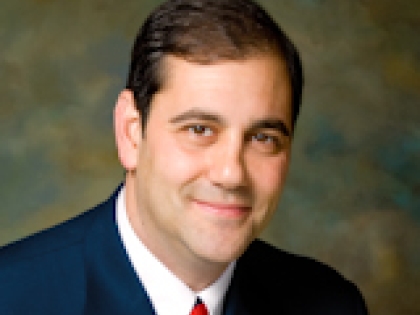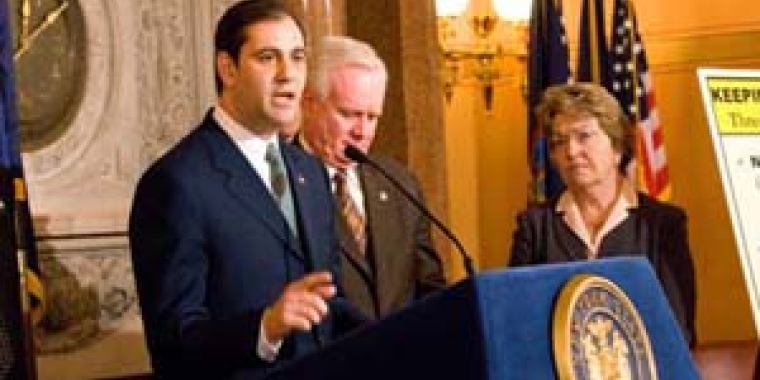
Senator Lanza, Assemblyman Cusick, Governor Cuomo, Attorney General Schneiderman, and Legislative Leaders Announce Agreement to Make New York State a National Leader in Fighting Prescription Drug Abuse
Andrew J Lanza
June 5, 2012
-
ISSUE:
- Agriculture
Senator Andrew Lanza and Assemblyman Michael Cusick today joined Governor Andrew Cuomo, Attorney General Eric Schneiderman, Senate Majority Leader Dean Skelos, and Assembly Speaker Sheldon Silver to announce a landmark agreement on a comprehensive prescription drug reform package that will make New York State a national leader in curbing prescription drug abuse.
The new law will include a series of provisions to overhaul the way prescription drugs are distributed and tracked in New York State, including enacting a “real time” prescription monitoring registry to provide timely and enhanced information to practitioners and pharmacists; requiring all prescriptions to be electronically transmitted; improving safeguards for the distribution of specific prescription drugs that are prone to abuse; charging a workgroup of stakeholders with the responsibility to help guide the development of medical education courses and other public awareness measures regarding pain management and prescription drugs; and requiring the Department of Health to establish a safe disposal program for unused medications.
Senator Andrew Lanza said, "This historic agreement will allow New York to be at the forefront of the battle against the prescription drug abuse epidemic, which has destroyed families and lives from one end of the state to the other. The agreed upon legislation will allow doctors and pharmacists to have the information they need to ensure that we turn the tide on this deadly crisis. I thank the Governor, Attorney General Schneiderman, Senator Skelos, the Speaker, Senator Hannon and Assemblyman Cusick for working so long and so hard in this cooperative effort."
Assembly Member Michael Cusick said, "I want to thank Governor Cuomo, Attorney General Schneiderman, Speaker Silver and all of my colleagues who worked together to craft this agreement. This is meaningful legislation that provides an essential tool to allow for the responsible dispensation of prescriptions by medical professionals and pharmacists. It will protect access to critical medication for patients who truly need it. But at the same time, appropriate controls will be implemented to restrict access of abusers and ensure those who profit from the abuse face the necessary consequences."
"This landmark agreement will help put a stop to the growing number of fatalities resulting from overdoses on prescription drugs," Governor Cuomo said. "We have seen too many untimely deaths as a result of prescription drug abuse, and today New York State is taking the lead in saying enough is enough. I commend Attorney General Schneiderman, Majority Leader Skelos, and Speaker Silver for their hard work in putting together this groundbreaking reform package that will help protect New Yorkers and put an end to prescription drug abuse."
Attorney General Eric Schneiderman said, "This is a major victory for the people of New York. With I-STOP, we will create a national model for smart, coordinated communication between health care providers and pharmacists to better serve patients, stop prescription drug trafficking, and provide treatment to those who need help. I applaud the Governor, Assembly and Senate for agreeing to take action and curb the prescription drug crisis that has impacted families in every corner of this state. Now, New York will be a national leader in protecting the public from the devastating consequences of prescription drug abuse."
Senator Kemp Hannon said, "Comprehensive action to address the misuse of painkiller drugs in New York is needed. In the last documented year, over 22 million prescriptions for painkilling drugs were written – without refills – in a state with only 19 1/2 million people. The cooperation and collaboration evidenced by this legislation marks the beginning, not the conclusion of a concentrated effort to bring a balance to these drugs. This bill reflects the Senate's work as evidenced by our two roundtables and a report, addressing the number one health crisis today."
Illicit use of prescription medicine has become one of the nation’s fastest-growing drug problem. According to the federal Centers for Disease Control and Prevention (CDC), nearly 15,000 people die every year of overdoses due to prescription painkillers. In 2010, 1 in 20 people in the United States over the age of 11 reported using prescription painkillers for nonmedical reasons in the past year. During the period 1999 through 2008, overdose death rates, sales, and substance abuse treatment admissions related to prescription painkillers all increased substantially. Sales of opioid painkillers quadrupled between 1999 and 2010. Enough opioid painkillers were prescribed in 2010 to medicate every American adult with 5mg of hydrocodone every four hours for a month. Moreover, an estimated 70 percent of people who abuse prescription painkillers obtained them from friends or relatives who originally received the medication from a prescription. The problem is of particular concern with respect to young adults and teens.
Details of the legislation are as follows:
The Creation of a New and Updated Prescription Monitoring Program (I-STOP)
The legislation will require updating and modernization of Department of Health (DOH)’s Prescription Monitoring program (PMP) Registry to make it one of the best systems in the nation to monitor prescription drug abuse and to help the medical community provide better care. The new system will substantially decrease opportunities for “doctor shoppers” to illegally obtain prescriptions from multiple practitioners. The legislation requires enhancement and modernization of DOH’s secure prescription monitoring program registry, which will include information about dispensed controlled substances reported by pharmacies on a “real time” basis, to effectively stop doctor shopping and combat the circulation of illegally-obtained prescription drugs.
The PMP Registry will be secure and easily accessible by practitioners and pharmacists, allowing them to view their patients’ controlled substance history. In addition, this legislation strikes the right balance by requiring health care practitioners to consult the PMP Registry before prescribing or dispensing the controlled substances that are most prone to abuse and diversion, while exempting practitioners from consulting in specific situations in order to protect patient access to needed medications. Moreover, pharmacists, for the first time, will now be able to consult the PMP Registry before dispensing a controlled substance.
Mandating Electronic Prescribing of Controlled Substances
The comprehensive package will make New York a national leader by being one of the first states to move from paper prescriptions to a system mandating the electronic prescribing (e-prescribing) for all controlled substances with limited exceptions. E-prescribing is critical to help to eliminate diversion that results from the alteration, forgery, or theft of prescription paper.
In addition, electronic prescribing enhances patient care by minimizing medication errors due to misinterpretations of handwriting on written prescriptions. It is estimated that 20 percent of the approximately 7,000 annual deaths caused by medication errors are attributable to misinterpretations of written prescriptions. Moreover, medication errors are estimated to cost the nation’s health care system over $70 billion each year. In New York, adverse drug events due to errors in written and oral prescriptions carry an annual cost to the health care system of approximately $130 million.
E-prescribing will also improve the efficiency of practitioners and pharmacies. Approximately 30 percent of prescriptions require pharmacists to call physicians due to poor handwriting on prescription forms. Additionally, e-prescribing is also more convenient for consumers, who would otherwise need to either wait at the pharmacy for a prescription to be filled, or make separate trips to drop off the prescription form and then pick up the medication.
E-prescribing of controlled substances will ensure that controlled substance transactions are transmitted in a secure, encrypted fashion to their intended recipient.
Updating the Controlled Substance Schedules to Stop Abuse of Certain Drugs, While Protecting Patient Access
The legislation combats prescription drug abuse by removing hydrocodone from Schedule III and placing it on Schedule II regardless of formulation. Hydrocodone is among the most abused and diverted prescription medications. In New York, last year, over 4.3 million hydrocodone prescriptions were filled — the most in the state. Nationally, eight percent of all high school seniors used hydrocodone for non-medical purpose. In 2009 alone, there were over 86,000 emergency room visits resulting from the non-medical use of hydrocodone.
Placing hydrocodone on Schedule II will control abuse by eliminating automatic refills and, in general, by limiting the amount prescribed or dispensed to a maximum 30-day supply. However, to protect legitimate access for those patients who need these drugs, the bill will not alter a practitioner’s ability under existing regulations to prescribe a supply of up to 90 days if he, or she, indicates on the face of the prescription that the patient has one of several enumerated conditions, including chronic pain.
The legislation will also add another drug, tramadol, to Schedule IV. Tramadol is a painkiller and is viewed as a drug of concern by the DEA.
Improving Education and Awareness of Prescribers to Stem the Tide of Prescription Drug Abuse
According to the CDC, a significant percent of abused medications are prescribed to the person that abuses them. This comprehensive legislation recognizes the need for increased education amongst health care providers about the potential for abuse of controlled substances, and the proper balancing of pain management with abuse prevention.
The bill would expand the functions of the workgroup to be established by the Department of Health under the existing Prescription Pain Medication Awareness Program, so that the workgroup will be responsible for making recommendations on: (1) continuing education for practitioners and pharmacists on pain management issues; (2) protecting and promoting access by patients with a legitimate need for controlled substances; (3) the implementation of the I-STOP provisions; and (4) inclusion of additional controlled substances in the consultation requirements of I-STOP. To carry out these functions, the Commissioner of Health will include additional stakeholders, including but not limited to consumer advocacy organizations, health care practitioners and providers, pharmacists and pharmacies, and representatives of law enforcement agencies.
Creating a Safe Disposal Program to Safely Dispose of Prescription Drugs
Recognizing that more than 70 percent of the abused prescription medications are obtained from friends or relatives, this legislation requires DOH to institute a program for the safe disposal of unused controlled substances by consumers. Through the program, DOH will work with local police departments to establish secure disposal sites for controlled substances on the premises of police stations. At these sites individuals can voluntarily surrender unwanted and unused controlled substances.
Under present law, individuals can only safely dispose of controlled substances during an approved take back event or, various methods of self-disposal that are either burdensome or harmful to the environment. Moreover, current federal regulations prohibit patients from returning unused controlled substances to pharmacists and doctors. This program will help alleviate this problem by providing a continual safe disposal option to New Yorkers.
Senate Majority Leader Dean Skelos said, "The effects of prescription drug abuse are being felt all across this state, especially among young people who are using painkillers to disastrous consequences. I commend Senator Lanza, who has championed this bill for more than three years, and Senator Hannon, the Chairman of the Senate Health Committee, for recognizing early on that a legislative remedy was a critical and necessary step. I thank the Governor, the Attorney General, and our colleagues in the Assembly for working with us to lead the charge in cracking down on prescription drug abuse so New Yorkers are better protected."
Assembly Speaker Sheldon Silver said, "Prescription drug abuse has become a pervasive problem in communities across the state. This legislation will help to control prescription drug abuse by creating a real-time online database enabling doctors and pharmacists to track certain controlled substances. This initiative will ensure patients receive the medication they need and deter those who seek to abuse them. I applaud Governor Cuomo for his leadership on this issue and commend Attorney General Schneiderman and my colleagues in the legislature for supporting this important life saving measure."
Share this Article or Press Release
Newsroom
Go to NewsroomSenate Passes Bridge Reform Legislation
October 22, 2007

Senator Lanza To Hold Mobile Office Hours
October 15, 2007

